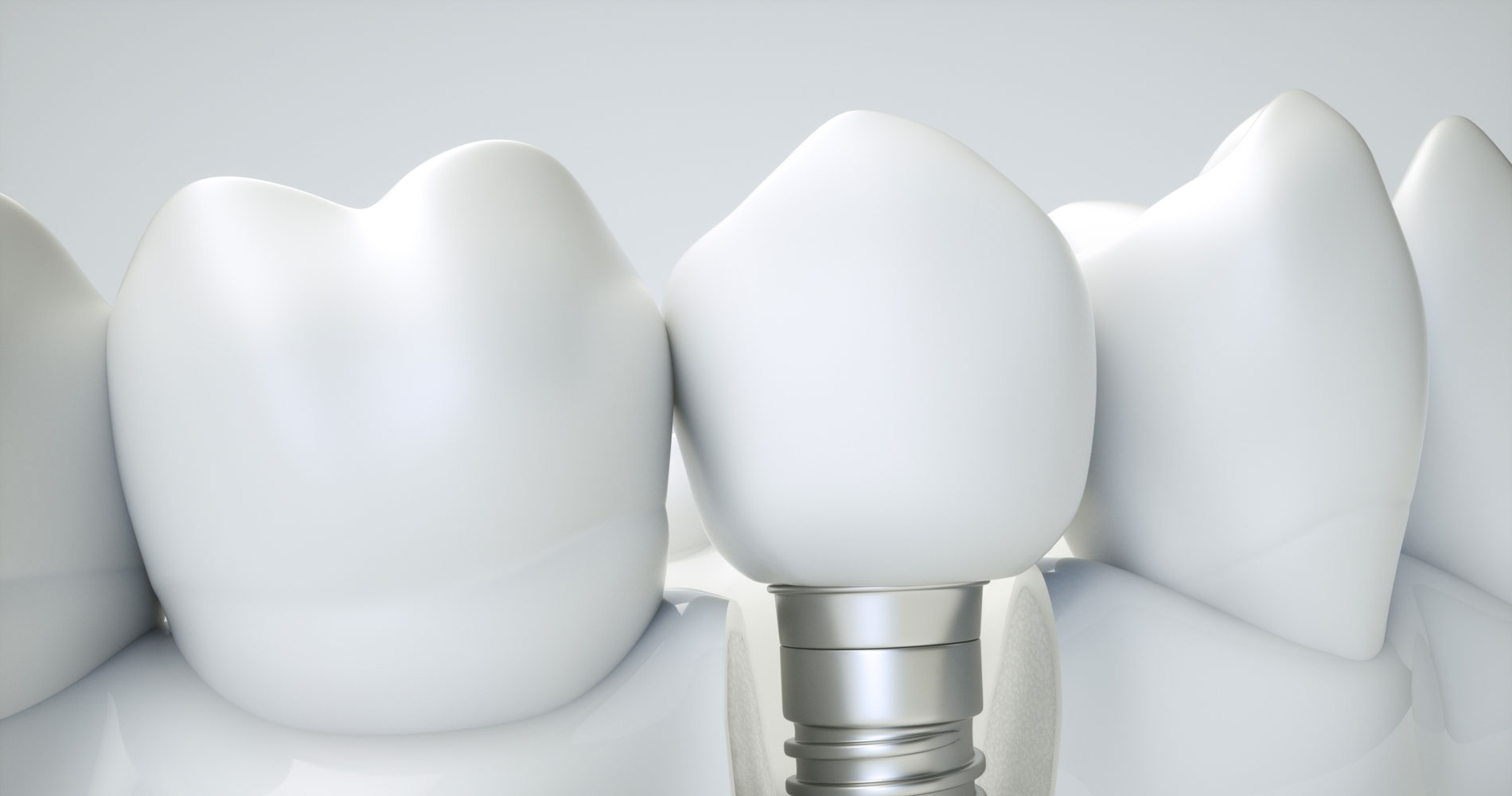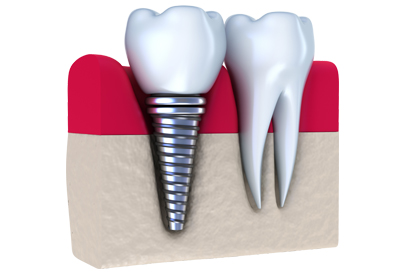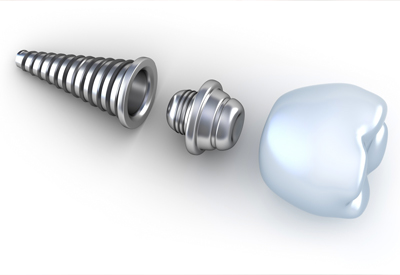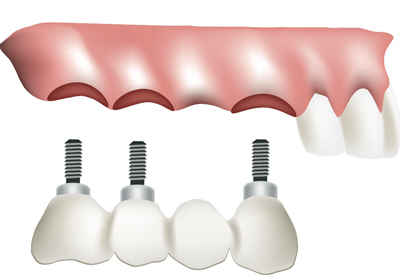
Introduction to Dental Implants
Dental implants are now the generally preferred tooth replacement treatment over partial dentures and fixed bridges. Traditional treatments either rest on your gums, as with removable dentures, or rely upon adjacent teeth to serve as anchors for fixed bridges. Dental implants are placed into the jaw bone, offering a highly successful, long-term replacement option.
Tooth Loss and Implants
Did you know an estimated 69% of adults ages 35-44 have lost a minimum of one tooth to either injury, decay, or gum disease? Moreover, by age 74, 26% of adults have lost all of their permanent teeth.
Dental technology now offers alternatives to the traditional methods of tooth replacement: dentures and fixed bridges, which are associated with increased complications over time. Removable dentures cause bone loss which impacts facial structure and can loosen or alter denture fit. Improperly fitting dentures can make embarrassing clicking sounds when eating or talking. Fixed bridges are placed by grinding down remaining adjacent teeth, also known as abutments, making these healthy teeth more susceptible to damage. Despite long-term complications, these treatments are still safe and viable.

Click each image
to learn more about dental implants.
What the research says
Research indicates that dental implants yield better long-term results for tooth replacement. Titanium implants are surgically placed into the jaw bone, where the implant fuses with the existing natural bone in a process called osseointegration. Properly integrated implants do not slip or make embarrassing noises and are more difficult to distinguish from your natural teeth. Because they mirror tooth and root structure, implants provide stimulation for the jawbone, preventing bone loss, while their titanium composition makes them resistant to decay. These factors contribute to the long-term success of dental implants and subsequent overall oral health.
Dental implant technology has been around for over 20 years. Not only does the technology continue to develop and improve, but it has also stood the test of time! Patients who received implants in the ’80s and ’90s continue to report optimum functionality of their implants. With proper care and hygiene, dental implants are truly a life-long solution for missing teeth.
Basics of a Dental Implant

An implant is made of three equally important pieces: the titanium implant, the abutment, and the crown. In the first step of the procedure, the implant is surgically placed into the jaw bone. After placement, the titanium implant begins to fuse with the jaw bone. This creates a connection between jaw and implant very similar to that between jaw and a natural tooth.
The next step is to fit the abutment over the part of the implant that is exposed above the gum line. Finally, the crown, the piece that looks like a natural tooth, is placed over the abutment.
Traditionally, patients missing only one tooth select a fixed bridge for tooth replacement; however, this treatment is not without complications. A bridge often damages the remaining natural teeth, which may otherwise have remained healthy. Bridges often need to be replaced once or twice over a lifetime, depending on the patient’s age. Similar complications exist with partial dentures. Within 5-7 years of treatment, there is as large as a 30% failure rate in either fixed bridge or partial denture replacements. Given the potential complications and required repair, these options can become more costly in the long-run, particularly for patients who receive replacements earlier in life.
Traditional procedures pose risks of complications, whereas implants promote overall oral and jaw health. The presence of natural teeth or implants helps to preserve the jaw bone. An extracted or lost tooth can cause the bone to weaken or erode. Bone grafting may be required to create sufficient bone structure in which to place the implant. Once placed, successful implants provide stability and work to maintain jaw health just as natural teeth do.
There is over 50 years of science and research that supports the use and success of dental implants. Often, they are the best long-term option for tooth replacement.
Dental Implants vs Dentures

Dental implants are versatile treatment tools as they can replace either one or multiple missing teeth. A patient can have multiple implants to support the replacement teeth that are needed.
Many patients who initially opted for removable dentures have switched to dental implants with positive results. Patients claim an improvement in quality of life! Implants feel and respond like natural teeth, allowing for more natural eating and eliminating embarrassing moments when dentures may have slipped or clicked. Additionally dental implants help to preserve your aesthetic appearance as they actively work to prevent bone loss.
Dental Implants
Made of titanium – Titanium is naturally compatible with the body, which allows the implant to fuse with the jaw bone.
Stability – An implant base mimics the root of a tooth within the jaw bone and gum. This allows implants to fit more naturally and securely, functioning similarly to natural teeth.
Replace Any Number of Teeth – Implants can replace one, few, or many missing teeth. Treatments are more tailored to patient’s needs.
Long-term Success – With proper care, implants generally never need to be replaced. Like your natural teeth, good oral hygiene ensures longevity and success of treatment.
Preserves Jaw Bone – Implants stimulate the jaw bone like natural teeth, preserving the jaw bone and preventing deterioration.
Dentures
Non-compatible materials – Dentures are made of acrylic, cast metal, and flexible plastic. These are not compatible with the body and can cause irritation to gums.
Instability – Dentures are not placed in a fixed location in the mouth and may move around and make clicking noises while eating or speaking. Natural chewing ability is impaired, which can impact nutrition.
Replace Many or All Teeth – Dentures are only a viable treatment option when many or all teeth are missing.
Replacements Needed – Dentures may need to be refitted or replaced as a result of age and deterioration of the gums and jaw bone.
Contribute to Bone Loss – Because dentures only rest on the gums, the jaw bone does not receive necessary stimulation and will deteriorate with time.
Single Missing Tooth
Many patients experience the loss of a single tooth due to injury, decay, or gum disease. Standard treatments for single tooth replacements include use of a removable partial denture, a fixed partial denture (bridge), or a dental implant. All of these options have their merits; however, implants are generally considered the most successful.
Removable Partial Dentures
Removable partial dentures are units in which replacement teeth sit on a base of gum-colored plastic, held together by a metal support structure. The partial is then attached to the gum line with a series of metal clasps. After placement, many patients express displeasure with the bulky denture and the metal aesthetic.
Fixed Partial Denture or Three Unit Bridge
A fixed partial denture, often called a bridge, suspends the replacement tooth or teeth between the remaining natural teeth on either side. The new tooth is cemented to the remaining teeth, referred to as abutments, which hold the prosthetic in place.
Before the bridge can be applied, the abutment teeth must be ground down to allow the bridge to be fitted over top of them.
Prior to dental implants, a bridge was considered the most effective method of single-tooth replacement, yet it was not without disadvantages.
The use of a bridge leads to jaw bone deterioration and tooth decay in the remaining abutment teeth. These complications have made fixed bridges a less desirable option in recent years as dental implants have become a more popular and widely used alternative.
Dental Implants for Single Missing Teeth
Today, dental implants are considered the best option for most single tooth replacements. They are the most natural treatment as they mirror the lost tooth and root. The titanium implant integrates into the existing bone and tissue in a process called osseointegration. The bond formed by this process is exceptionally strong and secure, allowing the implant to function like a natural tooth. The implant supports surrounding bone and tissue, enabling normal chewing and speaking and preserving the health of remaining teeth, gum, and bone. Implants offer a more permanent solution, although the crown of an implant may need to be replaced with extended use.
Caring for and maintaining your implant is like that of any other tooth; it requires daily brushing and flossing as well as dental check-ups twice a year. With basic hygiene, your implant can offer a lifetime of natural feeling teeth without impact your chewing or speaking.
Multiple Missing Teeth

Modern dentistry now views dental implants as the standard of care for replacing multiple teeth, particularly when they are in a row. Implants play a crucial role in preventing bone loss and preserving facial structure. Former treatments, such as dentures, not only failed to address these concerns, but in fact led to complications.
Dental Implants vs. Traditional Dental Bridge
A partial bridge is the most common solution for replacing multiple lost teeth; however, it is no longer considered the best treatment. The structural components of a bridge inflict permanent damage on the remaining teeth acting as anchors to support the bridge. Studies have shown that bridges often lead to additional tooth loss caused by wear and tear on what would otherwise have been healthy teeth.
Dental bridges allow the jaw bone to deteriorate because they do not stimulate the bone, whereas the roots of dental implants provide stimulation, protecting the jaw bone and supporting existing facial structure and shape. Because the titanium is compatible with the body, it is able to integrate into the jaw bone for a stronger replacement, increasing the permanency and longevity of the implant. Additionally, because the implant cannot be removed without of surgery, complications such as looseness or slipping are eliminated, allowing for normal eating and speaking.
Restoring Your Smile
Many factors contribute to the placement of implants in multiple teeth replacements. The first approach your doctor will consider is to place an implant at the site of each lost tooth. Such implants would be permanent replacements and act as your natural teeth. Not all patients qualify for implants at all sites of tooth loss. If too much bone loss has occurred, bone grafting may be necessary to create sufficient bone mass to hold the dental implant.
Another option is to use implants to create an implant supported bridge. Similar to traditional bridges, a prosthetic attaches to two abutment teeth; however, with dental implants, the anchor teeth are implants rather than remaining natural teeth. This reduces the risks of damage or loss of your remaining teeth.
During the procedure, two or more implants are placed with a temporary replacement, called a “flipper,” suspended between them for the duration of the healing period, which takes 4-6 months. Once the implants have fused with the jaw bone, the procedure is completed by attaching the permanent prosthetic between the implanted anchor teeth.
Implant Supported Dentures

Regular dentures rest on top of your gums, causing bone deterioration and leaving space that can cause complications such as loose fit, slipping, or clicking sounds.
Implant supported dentures are anchored in the mouth through attachment to dental implants. This type of dentures is most often used in the lower jaw where removable dentures are less stable, but can also be used in the upper jaw also.
Implant supported dentures are snapped into place on top of dental implants. This provides a secure fit and hold, eliminating looseness or slipping without the need for paste or adhesives. Implant supported dentures are designed so that they can be removed for regular cleaning, or you can opt for fixed implant supported dentures, which function as permanent teeth.
Bar-Retained Dentures
When fitting bar-retained dentures, three or more dental implants are placed into the jaw bone. Metal bars then run along the gum line between each of the implants. The denture rests on the bars, attaching with metal clips. This structure secures the denture’s placement without the need for the steel studs used in ball-retained dentures. Many patients have opted for this alternative as it eliminates the rubbing, loosening, and discomfort associated with traditional removable dentures.
Ball-Retained Dentures
Ball-retained dentures, also called stud-attached dentures, function with a ball and socket mechanism. The denture base has several sockets that line up with balls placed on dental implants in the jaw bone. The balls and sockets fit together for an extremely secure fit, allowing for an open palate denture. Ball and socket attachment is even less likely to slip or move, restoring the patient’s ability to eat and speak regularly.
Are Dental Implants right for me?
Recent technology has made it possible for almost anyone to qualify for dental implants. Missing teeth can diminish your quality of life by making it difficult to enjoy your favorite foods or speak clearly.

The traditional solutions to missing teeth (bridges, dentures, and crowns) lose their effectiveness over time, are difficult to maintain, and have negative consequences to your overall oral health. Implants offer a fantastic, natural-feeling alternative that restores your normal abilities. Implants provide the flexibility to replace one, a few, or many teeth, allowing your doctor to tailor your treatment to your mouth’s specific needs.
If you are interested in dental implants, schedule a consultation. Your doctor will evaluate your mouth and replacement needs to determine the most appropriate implant procedure. Implants are a viable option for most patients, having been successfully placed in patients with conditions such as diabetes, cancer, and heart disease.
Patients with the following pre-existing conditions and health risks should discuss these with their doctor during their implant consultation:
Implants can often improve or even replace existing dental work for a more effective and complete treatment.
Depending on how long your teeth have been missing, a certainly degree of bone loss will have occurred. Bone grafting may be required to rebuild the bone for successful implant placement.
You should discuss any existing medical conditions and medications with your doctor. Generally, if you are healthy enough for regular dental work, you should be equally as fit for implants.
If untreated, gum disease can impact the success of dental implants. Moderate to severe gum disease may need to be treated separately before implantation.
Smoking can limit the success of your dental implants as well as cause overall risks to your oral health. Discuss your smoking habits with your doctor.
